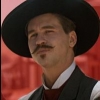I think I'm starting to understand what you're asking. If I'm understanding you right, you're saying you've used a single texture and repeated it across all the faces of the cube using UV coordinates. What you're wanting to do is to do as shown above where you have a T or t set of images in a single picture and you want to texture with that.
You could map those coordinates manually, but the easiest way to do this is what they call UV wrapping. That's where you take a complex model and texture it. Typically, you would make your model, in this case a cube, in a modeling program like Blender and then UV unwrap it to produce a UV map. You would then paint the model on the UV map texture and then wrap it around the model. This video seems to basically explain the process.
Another option is to assign a completely different texture to each face. I "believe" you have to model all 6 faces of the cube as completely separate squares. Then you can assign a texture to each square just like texturing any other square.
I don't believe there is a way to assign more than one UV coordinate to a vertex without getting pretty fancy with a custom shader. Typically, it's one set of UV coordinates per vertex and that means that vertex has to map to the same spot in the picture for all 3 faces it touches. That's why the above solution with UV wrapping works, but it won't work to assign completely different textures to a each face when they share a vertex. None the less, you can model it so each face has it's own vertex (6 quads where you use a lot more vertices) and then you can assign each a different set of UV coordinates and a completely different picture.
UV wrapping is what you want for most things, most of the time. The problem is that you are limited to the resolution of a single texture. So for a building, a single texture might be stretched too much over the entire building. You could model each wall of the building as a separate model and parent them together as a single object. Being separate models, they could each have their own UV maps and textures. You might even be able to use the same model for 3 sides of the building and then a different one for the front of the building requiring only two models with two textures and just repeating 1 of them 3 times. They can be joined as a single model in the modeling program even if they are not physically joined. In Blender, creating new models in edit mode will make all the models one object. Creating a new object in object mode will create completely separate objects.
One thing you might be able to do that could help you understand the T textures above is to to UV wrap a cube and then open up the data files to see what the UV coordinates look like. You're still between 0 and 1, but a single square could be from 0.5 to 0.75 or something like that. You are fitting all those different squares in the texture into texture coordinates between 0 and 1 since 0 is one corner and 1 is another.
These T shapes are pretty standard and pretty simple. So for them, you can if you really want assign the UV coordinates by hand to match the picture above. Presumably, the 4 squares going vertical are dividing the texture into 4 equal parts and so their Vertical UV coordinates are going to be from 0 to 0.25 to 0.5 to 0.75 to 1.0 right off the top of my head. I don't think it's divided so equally horizontally. So, you would probably have to try horizontal coordinates by trial and error. Remember that the model is likely sharing a single vertex and that vertex is mapping to a spot in the photo so that it works for at least 2 faces, and possibly 3.
Any time the model gets more complex than a cube, it's going to become impossible to do this by hand. Then you'll have to use a modeling program like Blender for UV wrapping and un-wrapping.
There are quite a few YouTube videos on UV wrapping. So, just do a search on that and you'll likely find more information that you want.









